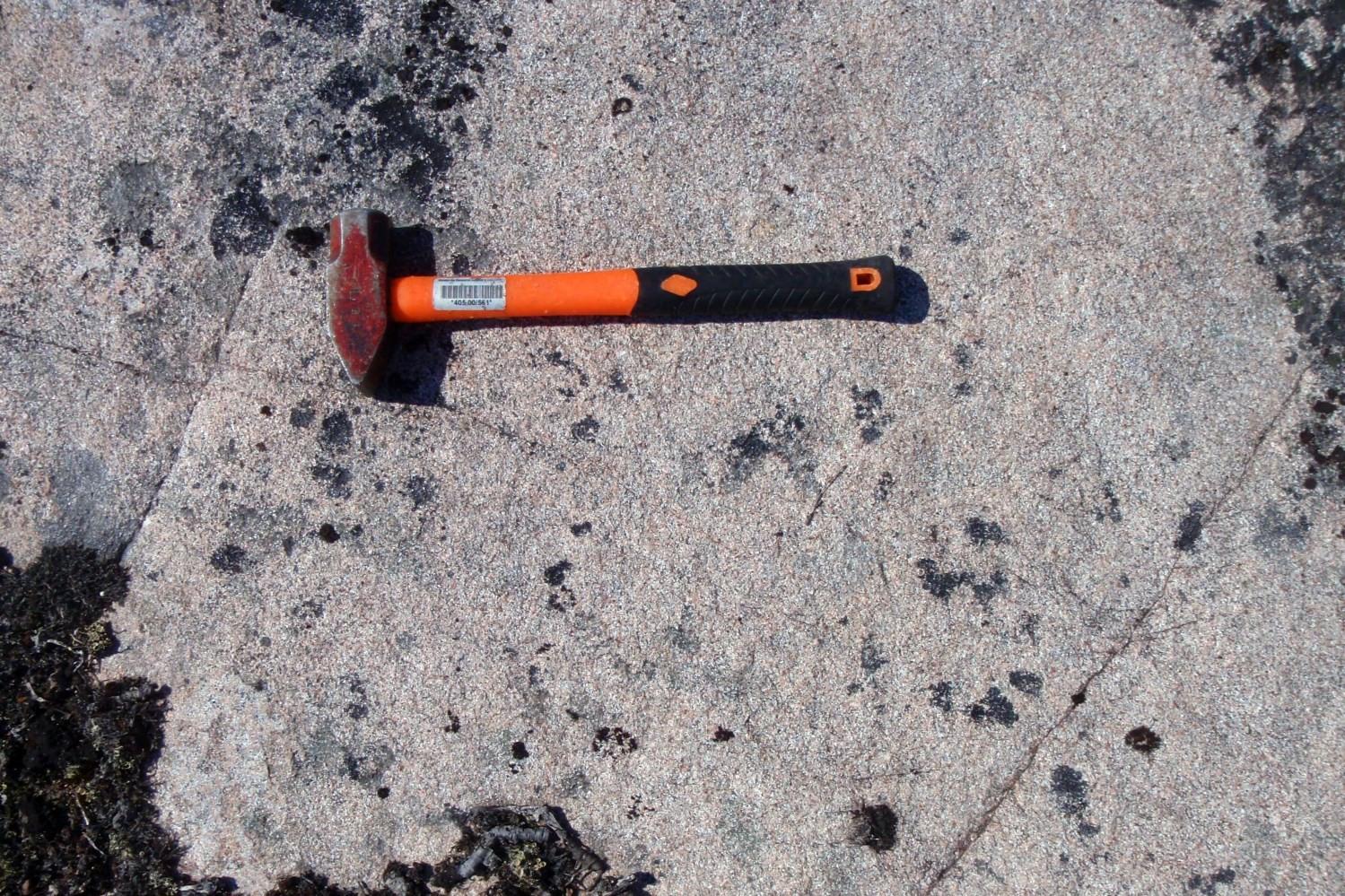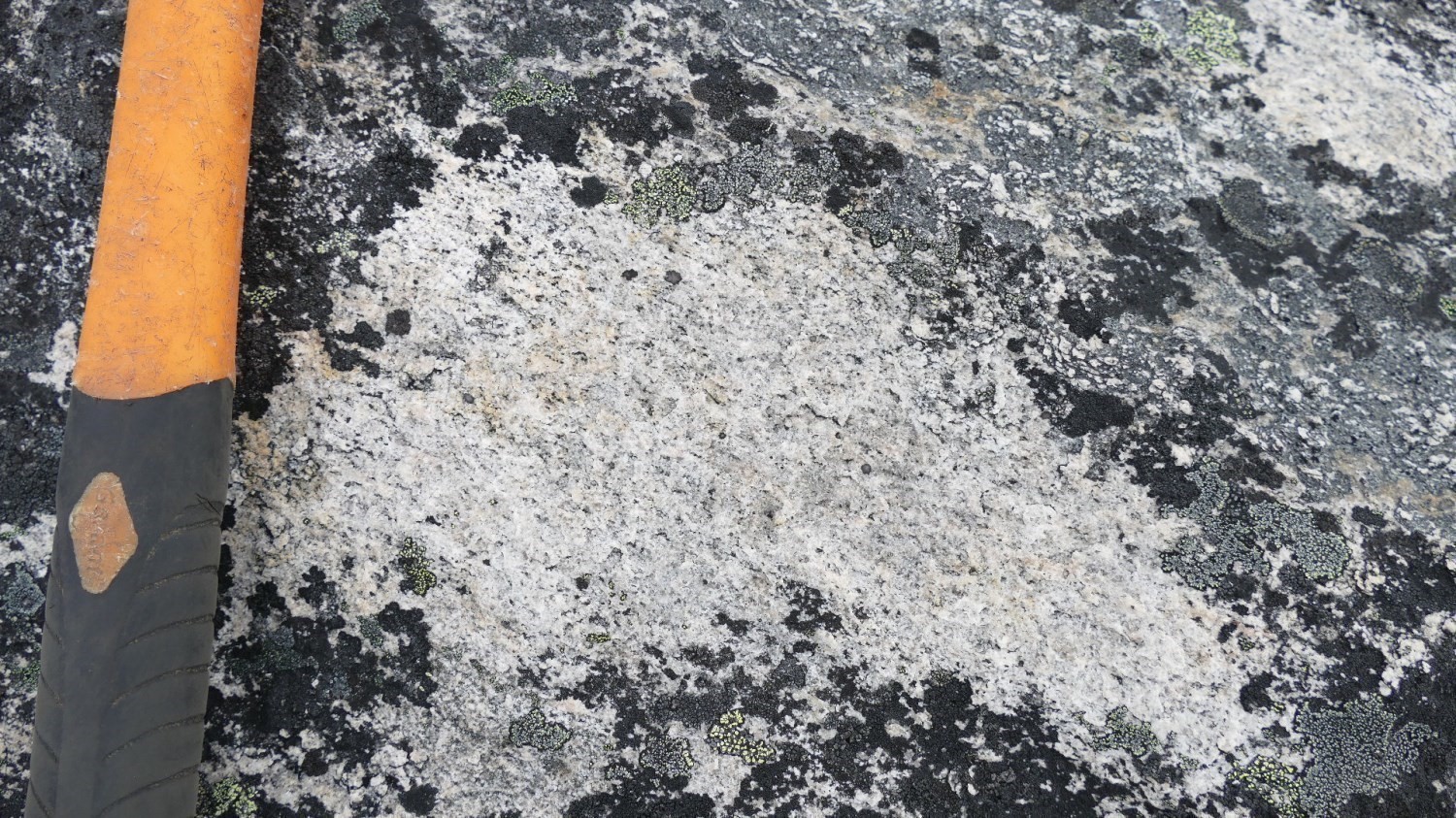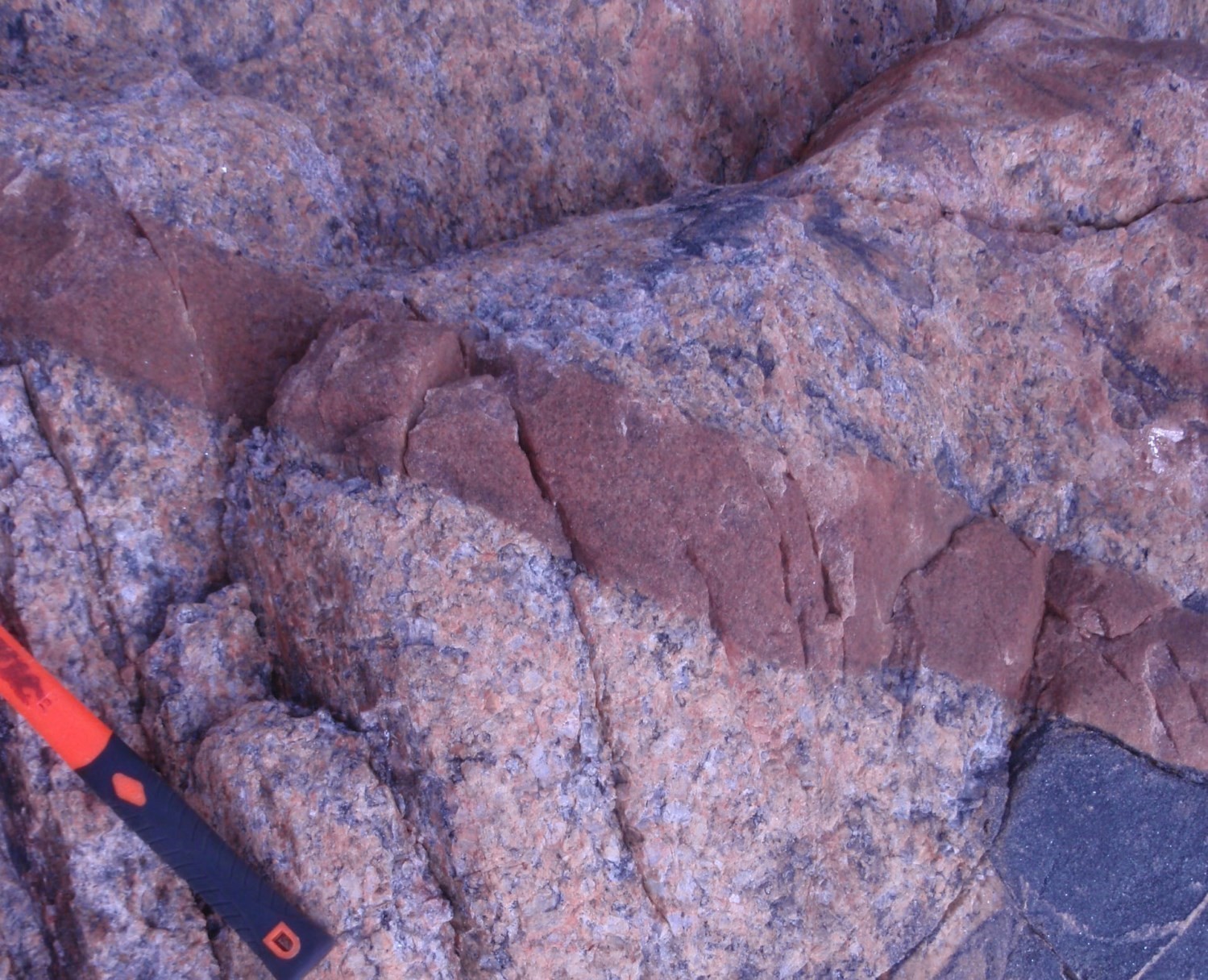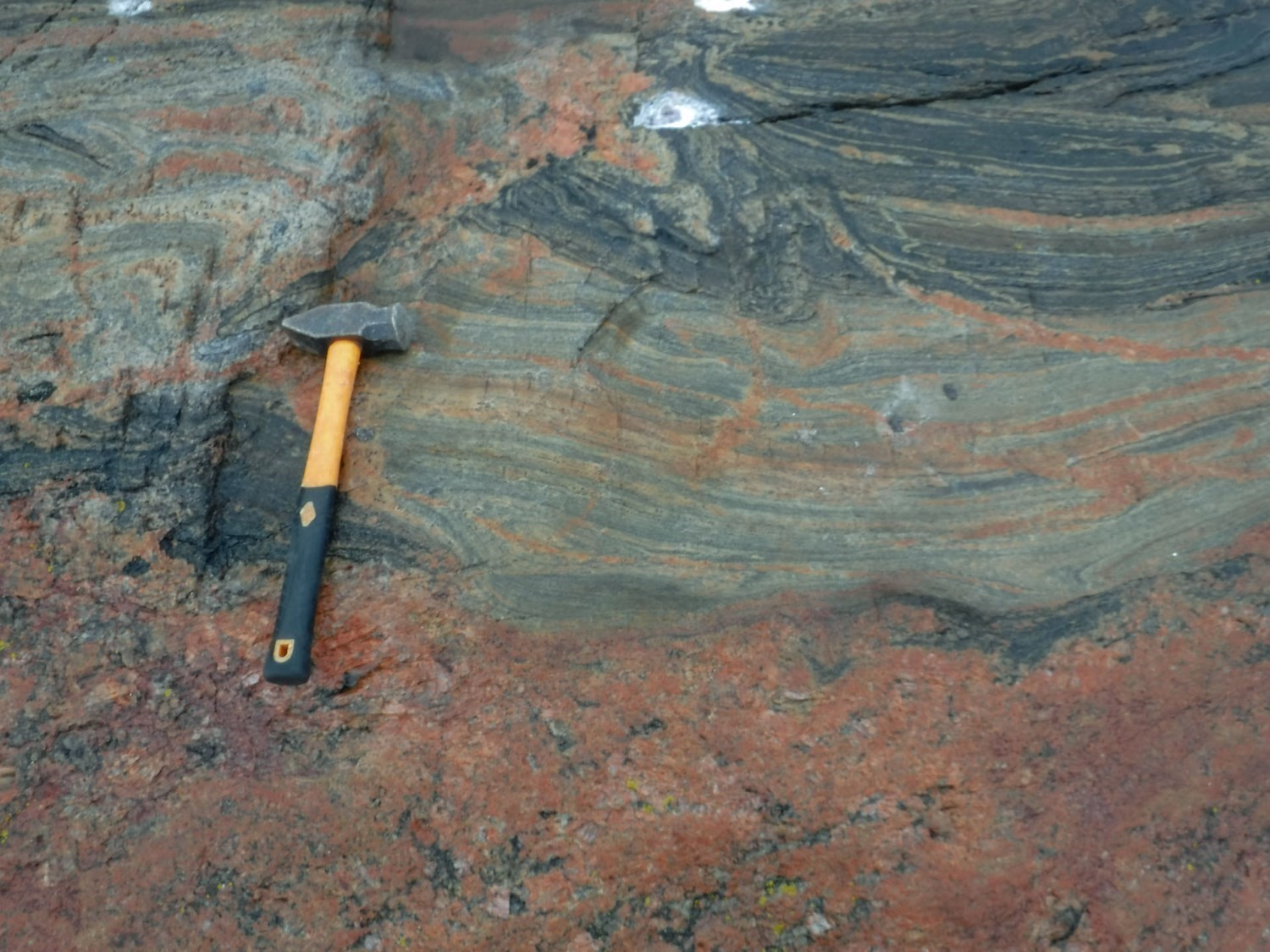
| Author(s): | Mathieu et al., 2018 |
| Age: | Paleoproterozoic |
| Stratotype: | None |
| Type area: | Koroc River area (NTS sheet 24I) |
| Geological province: | Churchill Province |
| Geological subdivision: | Falcoz Lithotectonic Domain |
| Lithology: | Granite |
| Category: | Lithodemic |
| Rank: | Suite |
| Status: | Formal |
| Use: | Active |
None
Background
The Qarliik Suite was introduced by Mathieu et al. (2018) in the Koroc River area to group Paleoproterozoic granite intrusions located east of the Moonbase (ZCmob) and Rivière George (ZCrge) anastomosing shear zones. These intrusions were previously assigned to the Baudan Complex (Verpaelst et al., 2000) to define a granitic gneiss and granitic intrusion unit. This unit’s name was not subsequently used by Simard et al. (2013) and Lafrance et al. (2015) who preferred to distinguish gneiss from late intrusions. The grey gneiss of tonalitic to granitic composition were then assigned to the Ungava Complex while the intrusions were grouped by these authors in the Dancelou Suite. Following the subdivision of the southeastern Churchill Province (SEPC) into lithotectonic domains as part of a synthesis (Lafrance et al., 2018), the definition of the Dancelou Suite was revised to contain only those granites located within the Baleine Lithotectonic Domain (Lafrance et al., 2020). Those of the Falcoz Lithotectonic Domain were grouped within the Qarliik Suite. Granites of the Dancelou Suite (1793-1748 Ma) are also younger than those of the Qarliik Suite (1832-1828 Ma). Lafrance and Vanier (2022) also included in the Qarliik Suite a quartz syenite unit previously assigned to the Inuluttalik Suite (pPina2d) by Mathieu et al. (2018). The table below synthesizes the correlations between current and historical units.
|
Revised Units (Lafrance and Vanier, 2022) |
Previous Units and Subunits |
Reference(s) |
|
pPqik1 |
pPdac1 (east of the ZCrge and ZCmob) |
Simard et al., 2013; Lafrance et al., 2015 |
|
pPqik2 |
ApPban3 |
Verpaelst et al., 2000 |
|
pPdac2 (east of the ZCrge and ZCmob) |
Simard et al., 2013; Lafrance et al., 2015 |
|
|
pPqik3 |
ApPban2 |
Verpaelst et al., 2000 |
|
pPdac3 (east of the ZCrge and ZCmob) |
Simard et al., 2013; Lafrance et al., 2015 |
|
|
pPqik4 |
pPina2d |
Mathieu et al., 2018 |
Description
The Qarliik Suite comprises four informal units: 1) beige granite (pPqik1); 2) pink granite (pPqik2); 3) pink pegmatitic granite (pPqik3); and 4) quartz syenite.
Qarliik Suite 1 (pPqik1): Beige Granite
 The granite of unit pPqik1 is homogeneous, beige or light grey, little or not magnetic and medium to fine grained. It has preserved an igneous appearance, but partial recrystallization is observed in thin section, particularly on grain edges. The foliation (or lineation) is generally well developed and defined by the alignment of mica and the beginning of an orientation of the matrix, especially for quartz (25-30%). The latter forms local lenses or bands in the most deformed zones. It has undulatory extinction and the rim displays dynamic recrystallization. K-feldspar (30-35%) is perthitic and commonly rimmed with myrmekites. Ferromagnesian minerals (5–10%) are represented by brown biotite, muscovite and chlorite (alteration of biotite). Plagioclase is slightly to moderately sericitized. Accessory minerals include epidote, allanite, opaque minerals, zircon (as inclusions in biotite) and sphene.
The granite of unit pPqik1 is homogeneous, beige or light grey, little or not magnetic and medium to fine grained. It has preserved an igneous appearance, but partial recrystallization is observed in thin section, particularly on grain edges. The foliation (or lineation) is generally well developed and defined by the alignment of mica and the beginning of an orientation of the matrix, especially for quartz (25-30%). The latter forms local lenses or bands in the most deformed zones. It has undulatory extinction and the rim displays dynamic recrystallization. K-feldspar (30-35%) is perthitic and commonly rimmed with myrmekites. Ferromagnesian minerals (5–10%) are represented by brown biotite, muscovite and chlorite (alteration of biotite). Plagioclase is slightly to moderately sericitized. Accessory minerals include epidote, allanite, opaque minerals, zircon (as inclusions in biotite) and sphene.
Qarliik Suite 2 (pPqik2): Pink Granite
The granite in this unit is characterized by its light to dark pink colour and generally medium to coarse grain size. It is homogeneous, of variable magnetic susceptibility, even grained and massive to moderately foliated. Where present, the foliation is marked by the alignment of ferromagnesian minerals and the beginning of an orientation of quartz. Decimetric clusters and dykes of unit pPqik3 pegmatitic granite are observed in several locations and are interpreted as a late phase of the unit. The igneous appearance is well preserved with very little recrystallization at the grain edges. The felsic phases are anhedral, and quartz (22–30%) forms zones with undulatory extinction that begin to make subgrains.
The granite contains 1 to 12% ferromagnesian minerals consisting of brown to green biotite flakes (variably chloritized), thin hematite dust and local hornblende. It also contains up to 2% muscovite flakes and displays low to moderate sericitization of plagioclase. Ferromagnesian minerals are scattered throughout the rock or form millimetric to centimetric clusters. Myrmekites are common and K-feldspar (30-45%) is dominated by microcline, which is locally perthitic and with quartz, plagioclase and muscovite inclusions. Microcline is slightly coarser than the other mineral phases. Accessory minerals can be quite numerous (<4%) and consist, in order of importance, of epidote, allanite, opaque minerals, sphene, apatite and zircon.
Qarliik Suite 3 (pPqik3): Pink Pegmatitic Granite
The pegmatitic granite comes in three forms: dykes cutting host rocks, metric to kilometric masses, and clusters or dykes in unit pPqik2 granite. Their appearance is generally massive, but some rocks are foliated and folded. It is pink or pink-black-white spotted. The granite contains 20 to 40% quartz, but is locally much richer, even resembling quartz veins. Quartz forms large zones with undulatory extinction. Microcline (25-38%) is perthitic and myrmekites are numerous. Plagioclase is locally sericitized and a slight recrystallization is observed at the grain edge. The pegmatitic granite contains 5 to 12% ferromagnesian minerals, which form centimetric clusters distributed heterogeneously in the rock. Biotite dominates ferromagnesian minerals and muscovite is generally associated with it. Accessory minerals are abundant and represented by epidote, allanite, apatite, magnetite, sphene and zircon.
Qarliik Suite 4 (pPqik4): Quartz Syenite
The quartz syenite is medium grained, pinkish grey in fresh surface with a light grey to beige patina. It contains 5 to 15% quartz, >70% K-feldspar and 2 to 20% ferromagnesian minerals. The latter consist of clinopyroxene (augite), hornblende and magnetite with lesser proportions of biotite and apatite. K-feldspar is perthitic with interpenetrating lobate rims.
Thickness and Distribution
The Qarliik Suite typically consists of elongated intrusions that are 2-20 km long and <3 km wide. It covers an area of ~821 km2 within the Falcoz Lithotectonic Domain. A larger intrusion of 23 km by 15 km has been observed in the NE part of this domain. Rocks of units pPqik2 and pPqik1 are the dominant lithologies, covering ~673 km2 and ~118 km2, respectively. The pPqik3 and pPqik4 units cover smaller areas (<25 km2).
Dating
Two datings in the Qarliik Suite (outcrops 1998-SP-4044 and 1998-SP-4079) yielded ages around 1830 Ma, indicating that these intrusions occurred towards the end of the Torngat Orogen (1885-1810 Ma; Charette, 2016; Charette et al., 2021), which affected the eastern part of the SEPC.
| Unit | Sample Number | Isotopic System | Mineral | Unit | Crystallization Age (Ma) | (+) | (-) | Reference(s) |
| pPqik2 | 1998-SP-4044E | U-Pb | Zircon | pPqik2 | 1828 | 2 | 2 | David et al., 2009 |
| pPqik3 | 1998-SP-4079B | U-Pb | Zircon | pPqik3 | 1832 | 11 | 11 |
Stratigraphic Relationship(s)
 The pPqik2 and pPqik3 units are commonly observed on the same outcrops. Although the pegmatitic granite is generally late with respect to the pink granite, the latter can also occur as dykes in the pPqik3 unit, suggesting that these units are contemporaneous or that there are multiple intrusive phases.
The pPqik2 and pPqik3 units are commonly observed on the same outcrops. Although the pegmatitic granite is generally late with respect to the pink granite, the latter can also occur as dykes in the pPqik3 unit, suggesting that these units are contemporaneous or that there are multiple intrusive phases.
 The granitic intrusions of the Qarliiq Suite cut the Archean units of the Kangiqsualujjuaq Complex and the Baudan Suite. Granite outcrops of the Qarliik Suite also contain 1 to 20% enclaves consisting of gneiss of the Kangiqsualujjuaq Complex and migmatites of the Fougeraye Complex (pPfog1). Its relationship with the Siimitalik Suite (nAsik) is more difficult to determine since this unit also includes a pink granitic phase similar to that of pPqik2, the former, however, being of Archean age. It is possible that some of the pink granites of the nAsik2 unit actually belong to the Qarliik Suite.
The granitic intrusions of the Qarliiq Suite cut the Archean units of the Kangiqsualujjuaq Complex and the Baudan Suite. Granite outcrops of the Qarliik Suite also contain 1 to 20% enclaves consisting of gneiss of the Kangiqsualujjuaq Complex and migmatites of the Fougeraye Complex (pPfog1). Its relationship with the Siimitalik Suite (nAsik) is more difficult to determine since this unit also includes a pink granitic phase similar to that of pPqik2, the former, however, being of Archean age. It is possible that some of the pink granites of the nAsik2 unit actually belong to the Qarliik Suite.
Paleontology
Does not apply.
References
Publications available through SIGÉOM Examine
DAVID, J., MAURICE, C., SIMARD, M., 2009. DATATIONS ISOTOPIQUES EFFECTUÉES DANS LE NORD-EST DE LA PROVINCE DU SUPÉRIEUR – TRAVAUX DE 1998, 1999 ET 2000. MRNF; DV 2008-05, 92 pages.
LAFRANCE, I., BANDYAYERA, D., BILODEAU, C., 2015. GÉOLOGIE DE LA RÉGION DU LAC HENRIETTA (SNRC 24H). MERN; RG 2015-01, 62 pages, 1 plan.
LAFRANCE, I., CHARETTE, B., VANIER, M.-A., 2018. Sud-est de la Province de Churchill, Nunavik, Québec, Canada: synthèse de la géologie. MERN; BG 2018-12
LAFRANCE, I., VANIER, M.-A., CHARETTE, B., 2020. Domaine lithotectonique de Baleine, sud-est de la Province de Churchill, Québec, Canada: synthèse de la géologie. MERN; BG 2020-07, 4 plans.
LAFRANCE, I., VANIER, M.-A., 2022. Domaine lithotectonique de Falcoz, sud-est de la Province de Churchill, Nunavik, Québec, Canada : synthèse de la géologie. MERN; BG 2022-01, 2 plans.
MATHIEU, G., LAFRANCE, I., VANIER, M.-A., 2018. Géologie de la région de pointe Le Droit, Province de Nain et sud-est de la Province de Churchill, Nunavik, Québec, Canada. MERN; BG 2018-07, 4 plans.
SIMARD, M., LAFRANCE, I., HAMMOUCHE, H., LEGOUIX, C., 2013. GÉOLOGIE DE LA RÉGION DE KUUJJUAQ ET DE LA BAIE D’UNGAVA (SNRC 24J, 24K). MRN; RG 2013-04, 62 pages, 1 plan.
VERPAELST, P., BRISEBOIS, D., PERREAULT, S., SHARMA, K. N. M., DAVID, J., 2000. Géologie de la région de la rivière Koroc et d’une partie de la région de Hébron, 24I et 14L. MRN; RG 99-08, 62 pages, 10 plans.
Other publications
CHARETTE, B., 2016. Long-lived Anatexis in the Exhumed Middle Crust from the Torngat Orogen and Eastern Core Zone: Constraints from Geochronology, Petrochronology, and Phase Equilibria Modeling. University of Waterloo; thèse de maîtrise, 389 pages. uwspace.uwaterloo.ca/handle/10012/10453
CHARETTE, B., GODET, A., GUILMETTE, C., DAVIS, D.W., VERVOORT, J., KENDALL, B., LAFRANCE, I., BANDYAYERA, D., YAKYMCHUK, C., 2021. Long-lived anatexis in the exhumed middle crust of the Torngat Orogen: Constraints from phase equilibria modeling and garnet, zircon, and monazite geochronology. Lithos; volume 388-389. doi.org/10.1016/j.lithos.2021.106022
Suggested Citation
Ministère de l’Énergie et des Ressources naturelles (MERN). Qarliik Suite. Quebec Stratigraphic Lexicon. https://gq.mines.gouv.qc.ca/lexique-stratigraphique/province-de-churchill/suite-de-qarliik_en [accessed on Day Month Year].
Contributors
|
First publication |
Isabelle Lafrance, P.Geo., M.Sc. isabelle.lafrance@mern.gouv.qc.ca (redaction) Mehdi A. Guemache, P.Geo., Ph.D. (coordination); anonymous (critical review), Simon Auclair, P.Geo., M.Sc. (editing); Céline Dupuis, P.Geo., Ph.D. (English version); Ricardo Escobar Moran (HTML editing). |
|
|
Revision(s) |
Isabelle Lafrance, P.Geo., M.Sc. (redaction) Céline Dupuis, P.Geo., Ph.D. (coordination); Marc-Antoine Vanier, Eng., M.Sc. (critical review); Simon Auclair, P.Geo., M.Sc. (editing); Dominique Richard, GIT, Ph.D. (English version); André Tremblay (HTML editing). |
|




